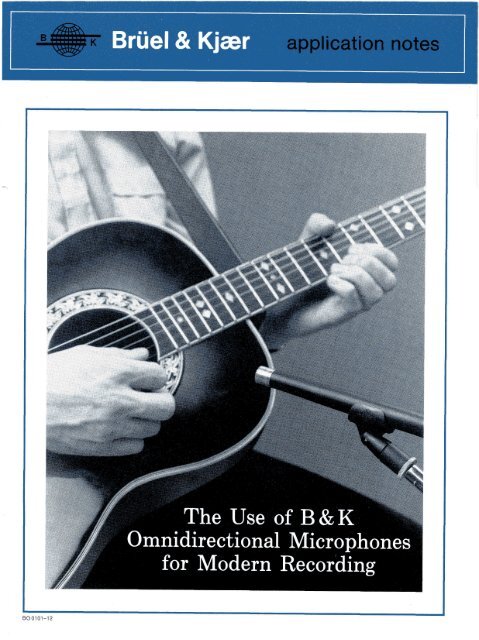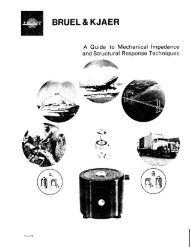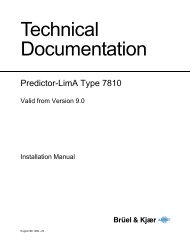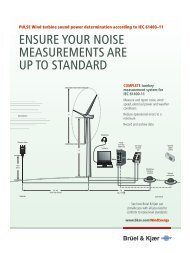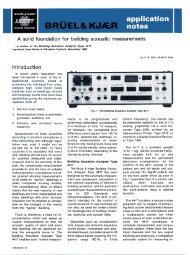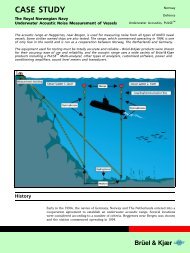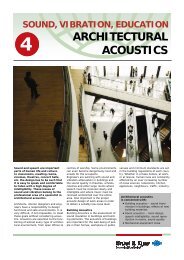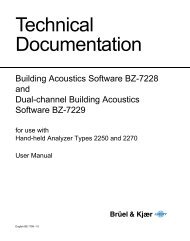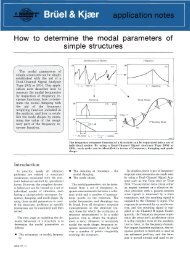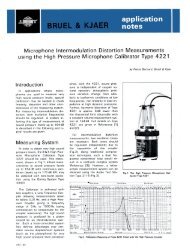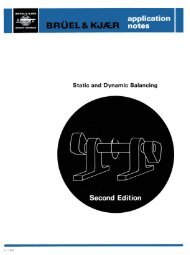The Use of B&K Omnidirectional Microphones for Modern Recording
The Use of B&K Omnidirectional Microphones for Modern Recording
The Use of B&K Omnidirectional Microphones for Modern Recording
You also want an ePaper? Increase the reach of your titles
YUMPU automatically turns print PDFs into web optimized ePapers that Google loves.
BO0101-12
<strong>The</strong> <strong>Use</strong> <strong>of</strong> B & K <strong>Omnidirectional</strong> <strong>Microphones</strong> <strong>for</strong> <strong>Modern</strong> <strong>Recording</strong><br />
Introduction<br />
Briiel&Kjaer has long set the stan<br />
dard <strong>for</strong> precision measurement<br />
equipment within the fields <strong>of</strong> acous<br />
tics and vibration. And, if you have<br />
ever "voiced" a pair <strong>of</strong> control room<br />
monitors, there is a good chance<br />
you've already used a B&K omnidi<br />
rectional microphone.<br />
Prior to 1978 I had not seen a B&K<br />
microphone used <strong>for</strong> an actual record<br />
ing session. It was then that I met an<br />
engineer by the name <strong>of</strong> Paul Grupp<br />
who had modified the pre-amp/power<br />
supply <strong>of</strong> a Type 4133 omnidirectional<br />
test microphone to make the noise lev<br />
el acceptable <strong>for</strong> recording purposes.<br />
<strong>The</strong> first application that I experi<br />
enced was a lead-vocal "overdub".<br />
Never had I witnessed a mic that de<br />
livered such a clear, crisp vocal sound.<br />
Since that time, I've used the<br />
4133/4134's in many diverse recording<br />
situations, in the few studios in the<br />
world that had made the same discov<br />
ery. It was only natural B&K realized<br />
* 7"")^ ^^ RIDEA U has been working as an engineer <strong>for</strong> eight years, record-<br />
I J ing sound <strong>for</strong> record and film both in the United States and in Europe.<br />
During this time he has also aided and advised in the construction <strong>of</strong> four<br />
recording studios, written <strong>for</strong> one <strong>of</strong> the recording industry's major periodi<br />
cals and produced several record albums.<br />
Front Cover: A typical set-up using B&K Type 4003 omni <strong>for</strong> recording a steel-string<br />
acoustic guitar. <strong>The</strong> author places the microphone some 10 - 20in from the upper finger<br />
board and angled slightly towards the sound hole. Similar set-ups can be used <strong>for</strong> related<br />
instruments such as mandolin and classical gut- or nylon-string guitar<br />
by David Rideau *<br />
3
this potential, and developed the 4000 come at a perfect time with regard to omni microphone. To suggest that<br />
series <strong>of</strong> Studio <strong>Microphones</strong>. <strong>The</strong>se the "state-<strong>of</strong>-the-art" <strong>of</strong> the recording these placements with regard to the<br />
mics have the same basic qualities <strong>of</strong> world. With digital recording in full respective musical instrument are the<br />
the 4133/4134: high power handling swing, improved analogue techniques, only possibilities is quite ludicrous.<br />
and excellent phase and frequency re- and the reintroduction <strong>of</strong> Direct-to- Sound and music both have very sub-<br />
sponse, in conjunction with a design Disc recording, never has there been jective qualities and few people can be<br />
that guarantees a low inherent noise more need <strong>for</strong> an accurate microphone in total agreement with others' im-<br />
level. Phantom powered models are with an extended dynamic range. pression <strong>of</strong> "sound", but the examples<br />
also now provided. to be shown here have been tested and<br />
In the next few pages I hope to in- used with success by myself and other<br />
Studio microphone design is not troduce some different possibilities engineers. We hope you have the same<br />
only a logical evolutionary step <strong>for</strong> (through mic positioning) that could or better success and are inspired to<br />
B&K to take, but its development has help you get the most from your B&K experiment with many other uses.<br />
Applications<br />
Vocals<br />
Undoubtedly, the most popular ap<br />
plication <strong>for</strong> the B&K omni micro<br />
phone is the vocal. Once most singers<br />
hear the clarity the 4000 series pro<br />
vides, there is no turning back. Re<br />
cording a "lead" with a B&K omni<br />
also has valuable "plusses", such as<br />
greater freedom <strong>of</strong> movement. With a<br />
"traditional" lead vocal set-up —<br />
large-diaphragm condenser mic set to<br />
the cardioid polar pattern -— there<br />
can be irritating problems with regard<br />
to singer/microphone relationships. As<br />
the singer moves closer to the mic<br />
there is a build-up in the low frequen<br />
cy area (proximity effect). In addition,<br />
the physical presence <strong>of</strong> these usually<br />
large-sized mics causes reflections be<br />
tween the microphone and the singer's<br />
face. This results in changes in the in-<br />
situ frequency response <strong>of</strong> the mic.<br />
Generally the artist finds a distance<br />
that is most pleasing to the engineer- Fig.l. <strong>The</strong> B&K omni mic provides a clarity on vocals that is hard to match using a<br />
/ j j * J. • -i-u +- J-<br />
/producer, and maintains that distraditional<br />
lead vocal set-up. Photo courtesy <strong>of</strong> Sound Track Studio, Copenhagen<br />
l J tance throughout the per<strong>for</strong>mance or<br />
'<br />
H b<br />
the sound quality can change drasti<br />
cally. <strong>The</strong> artist must also watch their<br />
"p's", since the mic is highly suscepti<br />
ble to vocal pops. In comparison,<br />
working with the 4000 series is almost<br />
care-free. I generally place the mic ap<br />
proximately 12 - 16 in (30 - 40 cm)<br />
directly in front <strong>of</strong> the artist's lips. In<br />
this position, with a respectable<br />
amount <strong>of</strong> in-line limiting, the singer<br />
has a great deal <strong>of</strong> freedom <strong>of</strong> move<br />
ment in all directions. Types 4003 and<br />
4006 in particular are inherently in<br />
sensitive to vocal pops so they are a<br />
very good choice <strong>for</strong> this application.<br />
Problems can also occur when a car-<br />
dioid/figure-<strong>of</strong>-eight polar pattern is<br />
used with a group <strong>of</strong> "background"<br />
singers; they must <strong>of</strong>ten crowd togeth<br />
er to be on the "right side" <strong>of</strong> the Fig.2. A group <strong>of</strong> background vocalists encircling a B&K 4004 solves any problems about<br />
microphone's polar pattern. A person being on the "right side" <strong>of</strong> a mic's polar pattern<br />
4
who is more to one "side" <strong>of</strong> the polar higher degree <strong>of</strong> omnidirectivity. two or twenty singers, vocalists can<br />
pattern <strong>of</strong>ten suffers in terms <strong>of</strong> fre- Place the mic pointing straight up to- gather around the mic, positioning<br />
quency response and sensitivity. wards the ceiling, the height <strong>of</strong> the themselves com<strong>for</strong>tably with the only<br />
capsule being just below the chin <strong>of</strong> consideration being their personal<br />
For backgrounds I would recom- the smallest singer. With this place- output level relative to the distance to<br />
mend a 4004/4007 owing to its even ment, regardless <strong>of</strong> whether there are the microphone and to other vocalists.<br />
Acoustic Piano<br />
Acoustic Piano is another popular<br />
application <strong>of</strong> the B&K omni. This is<br />
probably due to the "colourless" quali<br />
ty <strong>of</strong> the mics over the entire frequen<br />
cy spectrum. Some engineers can't un<br />
derstand how one can create a stereo<br />
image utilizing omnidirectional mics.<br />
But as other engineers have proven, it<br />
is very possible and <strong>of</strong>ten beneficial.<br />
Basically you're creating a stereo<br />
picture by the relationship <strong>of</strong> the dis<br />
tance between microphones with re<br />
spect to the distance to the sound<br />
source. And it's very suprising just<br />
how little distance is needed between<br />
the microphones be<strong>for</strong>e a stereo "pic<br />
ture" appears. With the very wide,<br />
very flat frequency response and re<br />
sulting fine time definition <strong>of</strong> the<br />
B&K mics, only small distances are<br />
required between mics to create a sta- , „ > , - „ . , ,,, , , , , •<br />
v, ii i r- J • „CTP tig.3. A free-hanging acoustic baffle can be suspended between two microphones to create<br />
' a more dramatic stereo effect<br />
When I record a concert grand pi- dramatic stereo effect, I sometimes oval-shaped baffle).) <strong>The</strong> result is a<br />
ano in an overdub situation, I general- employ a "free hanging" baffle. <strong>The</strong> piano sound with great stereo imaging<br />
ly place one omni 10 in (25 cm) directly baffle consists <strong>of</strong> a 14 x 14 x 3 in (35 x and equal power in every octave. Us-<br />
above the hammers at about "High" C 35 x 7,5cm) block <strong>of</strong> wood with a lin ing the 4004/4007, subtle nuances are<br />
in relation to the keyboard. About (2,5 cm) layer <strong>of</strong> semi-rigid isolation captured, while at the same time<br />
12 in (30 cm) towards the lower regis- (4 l /2 pounds per cubic foot density) on maintaining excellent headroom, with<br />
ter <strong>of</strong> the keyboard and 10 in (25 cm) each side. Hanging by string on a third good high and low frequency transient<br />
in from the hammers towards the end mic stand, the baffle is placed between response. Those low tones really bene-<br />
<strong>of</strong> the piano, I place the second mic. the mics. (I have seen or heard many fit from the extended low-end <strong>of</strong> the<br />
This pair alone creates a reasonable variations <strong>of</strong> this theme, reminiscent B&K mics.<br />
stereo picture, but <strong>for</strong> an even more <strong>of</strong> the Jecklin disc (<strong>for</strong> example, an<br />
Percussion<br />
<strong>The</strong> 4004/4007 model is ideal in the 20in (25 - 50cm), over the drum head<br />
percussion overdub situation. In high without impairing the player's free-<br />
frequency transient response it is un- dom <strong>of</strong> movement. This placement<br />
equalled. It can also handle a tremen- provides the "slap" that is frequently<br />
dous overall level where most other lost when recording these instru-<br />
condenser mic capsules fail. Generally, ments. For glockenspiel, vibraphone,<br />
when I record percussion such as tarn- and marimba, you can also achieve a<br />
bourine, shaker, cowbell, and other most faithful reproduction by using<br />
small hand- held instruments, I have the same placement (10 - 20 in over<br />
the musician stand somewhere be- the instrument). <strong>The</strong>se instruments in<br />
tween 30 - 60in (75 - 150 cm) from the particular utilize the "purity" and<br />
mic which is placed about chest level. "brilliance" <strong>of</strong> the 4004/4007.<br />
Dynamics can vary wildly, so there is<br />
usually also a "fast" limiter in line.<br />
Fig. 4. Incorporating ambience in an over-<br />
^ ■> . j . , i dub situation. <strong>The</strong> reverberation<br />
ror skinned instruments such as ,■ /D^^m * *.i. * A- ■ no *<br />
time (Kl 60) <strong>of</strong> the studio is 0,8s at<br />
congas, bongos, african drums, e.t.c, I 500Hz. Photo courtesy <strong>of</strong> Easy<br />
place the mic as close as possible, 10 - Sound Studio, Copenhagen<br />
5
String Family<br />
String instruments can benefit (±2dB) up to 11 kHz. Larger diame- pointing directly over the two musi-<br />
greatly from the accuracy <strong>of</strong> the B & K ter, low-noise Types 4003/4006 are dans' chairs at a distance <strong>of</strong> about 5 -<br />
mics in a diffuse field. Almost always supplied with an additional protection 7 ft (1,5 - 2 m) depending on the rever-<br />
when a string instrument or section is grid which may be fitted in place <strong>of</strong> Deration characteristics <strong>of</strong> the studio<br />
miked, one should incorporate the the standard grid to give a Hat diffuse used. Violas are also miked in the<br />
natural ambience <strong>of</strong> the room being field response up to approximately same manner. With celli, I place the<br />
used. Often a large diaphragm con- 15 kHz. mic just over the bridge at a distance<br />
denser mic (even when set to the om- <strong>of</strong> 10 - 30in (25 - 75cm). This should<br />
nidirectional polar pattern) can pro- For a normal "pop" string session produce that "resin" sound <strong>of</strong> bow<br />
ject a "blurred" spatial image <strong>of</strong> the which usually consists <strong>of</strong> 6 to 12 vio- movement that is <strong>of</strong>ten lacking in the<br />
room's "reverberance". <strong>The</strong> diffuse lins in "pairs" (with two players read- recording <strong>of</strong> this instrument. Double<br />
field response <strong>of</strong> the smaller diameter ing one set <strong>of</strong> music) I place a bass is miked in the same manner.<br />
B&K Types 4004/4007 is linear 4003/4006, with the special grid,<br />
Wind Instruments<br />
Brass instruments with their wide For clarinet, bass clarinet, flute rally, demanding a more distant "over-<br />
dynamic range and sometimes brutal e.t.c, I place the 4003/4006 6 - 16 in all" mic placement. But, even in the<br />
high-end transient, can be a problem (15 - 40cm) over the valve area, ap- ensemble overdub situation, an overall<br />
to record. For trumpet, coronet, trom- proximately in the middle <strong>of</strong> the mic can be essential in creating a nat-<br />
bone, ilugelhorn, e.t.c, the 4004/4007 instrument. ural blend <strong>of</strong> instruments. Try to<br />
does the job magnificently. Placed 6 place a "stereo pair" 12 - 16 in (30 -<br />
-16in (15 - 40 cm) from the "bell", Please keep in mind that the previ- 40 cm) apart, just behind the conduc-<br />
these mics will reproduce every subtle ously mentioned wind and string in- tor and 2 - 6ft (0,6 - 1,8m) above his<br />
detail <strong>of</strong> a musician's tone. strument placements are recommend- head, depending on the size <strong>of</strong> the<br />
ed with the small-ensemble overdub groups and the studio ceiling height.<br />
For saxes I place the 4003/4006 at situation in mind. In this setting, This signal blended with the individ-<br />
about the same distance over the close-miking techniques are required ual mics <strong>of</strong>ten produces a very pleas-<br />
"bell" <strong>of</strong> the horn, but slightly favour- to provide isolation between instru- ing combination.<br />
ing the "valve" side <strong>of</strong> the instrument. ments so that the engineer/producer<br />
Through experimentation you can can control any imbalances that may<br />
find a particular musician's "sweet" exist in the studio. In a classical set-<br />
spot, which varies according to the ting these balances between instru-<br />
player's personal style. ments or sections should occur natu-<br />
Fig. 5. Ouerdubbing sax and trumpet, with<br />
the mics. placed about 8in (20cm)<br />
840415<br />
from the bell. Photo courtesy <strong>of</strong> Easy Fig. 6. Microphone positioning <strong>for</strong> a recording <strong>of</strong> the Royal <strong>The</strong>atre Opera Company at<br />
Sound Studio, Copenhagen Easy Sound Studio, Copenhagen, August 1981<br />
Guitars<br />
<strong>The</strong> "clarity" that can be achieved <strong>of</strong> the upper finger board and angled course applies to the other stringed<br />
with the B&K omnidirectional on a slightly towards the sound hole, the instruments in the same family: classi-<br />
steel-string acoustic guitar is hard to artist enjoys the same freedom <strong>of</strong> cal guitar (nylon- or gut-string), man-<br />
be beaten by other mics. With the mic movement as a lead vocalist. This dolin, e.t.c.<br />
placed 10 - 20 in (25 - 50 cm) in front same placement <strong>of</strong> the 4003/4006 <strong>of</strong><br />
6
"perfection" proves to be undesirable. fiat frequency response and headroom<br />
I place a large diaphragm condenser the 4004/4007 can provide. Place the<br />
set to the cardioid polar pattern at mic directly in front <strong>of</strong> the loudspeak-<br />
approximately twice the distance from er at a distance <strong>of</strong> 6 - 12in (15 -<br />
the instrument as the B&K mic. A 30cm), and limit to taste.<br />
combination <strong>of</strong> these two signals al<br />
most always provides a final product<br />
that both the musician and I can agree<br />
on.<br />
For electric guitars I must admit to<br />
being partial to the ''tight", "compact"<br />
sound a dynamic mic provides when<br />
placed directly in front <strong>of</strong> the speaker<br />
cabinet. This is due largely to its limit<br />
ed frequency response. But, I also<br />
place a 4003/4006 some 5 - 10 ft (1,5 -<br />
3 m) in front <strong>of</strong> the cabinet. <strong>The</strong> addi-<br />
Fig. 7. Guitars, mandolins and related in- tion <strong>of</strong> a gmall amount 0f this signal to<br />
struments enjoy the clarity <strong>of</strong> a the ojigingl gi { can produce a mce<br />
closely placed B&K mic. ,, „ .., . , . , i<br />
open quality that is very hard to<br />
create electronically. For "heavy" rock<br />
guitar sounds, employing a larger cab-<br />
On several occasions when I have inet, I will even add a third mic<br />
used the B&K in this way, I have (4003/4006 with special grid) at an<br />
experienced "side-effects" in the <strong>for</strong>m even greater distance if it's the "are-<br />
<strong>of</strong> a musician's fears. Never be<strong>for</strong>e na" type ambience the artist is looking<br />
, i i j , i • n i- rig. 8. For a more open sound when miking<br />
have they heard their per<strong>for</strong>mance re- tor. to J , , . , . f<br />
^ an electric guitar, a second mic such<br />
produced so perfectly. Every little de- as the 4003/06 can be placed at some<br />
tail which previously escaped unno- Electric-bass cabinets are another distance from the cabinet, and add<br />
uced can now be heard. When this story. <strong>The</strong>y genuinely appreciate the ed to taste<br />
Drums<br />
<strong>The</strong> drum set in the modern studio<br />
is one <strong>of</strong> the most difficult challenges<br />
<strong>for</strong> a recording engineer. Often, one is<br />
required to create a "fantastic" sound,<br />
while at the same time maintaining<br />
isolation within the drum kit itself <strong>for</strong><br />
later artistic control. This undoubted<br />
ly results in a microphone on every<br />
torn, or between every two toms (the<br />
latter more desirable being less prone<br />
to phase problems). Also there are<br />
separate mics on the snare drum, bass<br />
drum and high-hat, two overhead<br />
mics, and even one or two used as<br />
ambience mics. In this situation it is<br />
very hard to do the entire set-up with<br />
omnidirectional mics. I usually begin<br />
with large-diaphragm condenser mics<br />
set to the cardioid polar pattern and<br />
placed 3 - 6in (7,5 - 15 cm) over each<br />
tom-tom, or one mic placed slightly<br />
higher between every two toms. In ei<br />
ther case the diaphragm is positioned<br />
over the rim <strong>of</strong> the torn, towards the Fig. - 9 - <strong>The</strong> modern drum sound can prove quite a challenge with many varied mics being<br />
front <strong>of</strong> the set. For the snare I usually use d to attain the overall sound an artist or producer is seeking. Here, a 4004/07 is<br />
use a dynamic mic to aid in isolation place u d > f 8h ? ly ?f"*> inside th , e kick ~ drum to P mde a dean > C P sound - An<br />
f.nm tu i^u v,Q+ Ti a Ar\(\AiA(\cn ..„ overhead pair <strong>of</strong> 4004/07 s proves pleasing, giving cymbals a transparent quality and<br />
trom the nigh-Hat. lne 4UU4/4UU/ can a fmdy^uned stereo image <strong>of</strong> the compiete drum kit<br />
be used in many instances <strong>for</strong> the bass<br />
drum, providing a "crisp" and "clean"<br />
kick sound. Placement can be very dif- placed inside the drum, slightly <strong>of</strong>f- some type <strong>of</strong> cover or enclosure <strong>for</strong> the<br />
ferent depending on the drum, but I center and 10 - 20 in (25 - 50 cm) from bass drum itself in case more isolation<br />
like the front head "<strong>of</strong>f with the mic the back head. Be prepared to use from the rest <strong>of</strong> the set is needed. I<br />
7
generally use some sort <strong>of</strong> isolation time checking coverage <strong>of</strong> cymbals, rienced was a session a fellow engineer<br />
anyway, even when using a cardioid You can then mix in the individual and I had agreed to do <strong>for</strong> a group that<br />
pattern mic. tom-tom mics as needed, if needed at needed a quick, "very rough" demo-<br />
all: tape. With this in mind we did a<br />
<strong>The</strong> overhead mic position is where quick, "very rough" set-up that con-<br />
the B&K mic can really shine, giving Everyone is aware that the more sisted <strong>of</strong>, among other things, dynamic<br />
cymbals that "transparent" quality. mics you use <strong>for</strong> a particular instru- mics on bass and snare drum with a<br />
Place 4004/4007's on either side <strong>of</strong> the ment, the greater the chances are that single B&K omni mic over the drum-<br />
kit just outside the drummer's shoul- phase atrocities will occur. What the mer's head. <strong>The</strong> clarity and transpar-<br />
ders and 12in (30cm) or more over his B&K omnis as overheads can <strong>of</strong>ten ency <strong>of</strong> the toms and cymbals were<br />
head. Experiment with the "fine-tun- provide, is a better overall picture quite impressive! Alas, it's a stereo<br />
ing" until you achieve a good stereo where individual mics are less essen- world ...but how much <strong>of</strong> our sound<br />
picture <strong>of</strong> the set (mics placed Lef- tial to the final product. I remember should we compromise?<br />
t/Right in the monitors), at the same one <strong>of</strong> the best drum sounds I've expe-<br />
Special Applications and Considerations<br />
Speech and Effects<br />
Because <strong>of</strong> the realistic accuracy <strong>of</strong> ing <strong>for</strong> several films and many albums its in these respects I suggest having<br />
the B&K omni I have found it to be a I've recorded breaking glass, firecrack- someone light a match when you have<br />
prime choice <strong>for</strong> recording speech and ers, footsteps, e.t.c, all with wonderful the mic set at a level <strong>for</strong> normal<br />
special effects. In the course <strong>of</strong> record- results. As an introduction to its mer- speech. I think you'll see what I mean!<br />
"Good" Leakage<br />
"Leakage" in the recording world I finally agreed to the idea and sub- but instead <strong>of</strong> the "boxy" unusable<br />
has become a bad word. Most <strong>of</strong> the sequently used B&K omnis on the leakage we are too used to hearing, it<br />
time engineers will go to great lengths piano, sax, and vocal, after unsuccess- was a pleasant leakage that could easi-<br />
to hold the levels as low as possible in fully trying several other directional ly blend with the other signals, pro-<br />
order to avoid instruments "leaking" mics. I placed several "gobos" in stra- ducing a minimum <strong>of</strong> phase colour-<br />
into microphones that were not in- tegic areas, but no one was deprived <strong>of</strong> ation. Naturally in these cases, posi-<br />
tended <strong>for</strong> them. In general this ap- direct eye contract. I then proceeded tioning is critical (I used the theory <strong>of</strong><br />
proach is the quite correct, but in cer- to bring up the faders and was sur- equal or even multiple distances be-<br />
tain special conditions, leakage can be prised that the leakage situation was tween all the various mics: the piano<br />
used advantageously. For instance, I not as bad as I had anticipated. Mix- mics were 20 in (50 cm) from each oth-<br />
once recorded a jazz singer whose ing afterwards was a "breeze", simply er, the vocal mic 40 in (lm) from the<br />
group consisted <strong>of</strong> drums, sax, piano, bringing up the faders until I heard a high piano mic, the sax mic 40in (lm)<br />
and upright bass. <strong>The</strong> singer/group- reasonable balance between all the from the vocal mic, e.t.c.) but a little<br />
leader could understand why I had to members, and that was that. Other experimentation can bring rewarding<br />
use a "drum booth" to keep this in- than a few subtle moves <strong>for</strong> solos and results.<br />
strument from "spilling" into all the more difficult vocal passages, the mix<br />
other mics, but couldn't understand basically took care <strong>of</strong> itself!<br />
why she and the other band-members<br />
couldn't gather "cozily" around the Of course there was leakage between<br />
open concert-grand piano. all the instruments and microphones,<br />
Diffuse Fields<br />
Owing to the excellent phase re- and corresponding faithful rendition effectively as a mic in a live chamber.<br />
sponse at all angles <strong>of</strong> incidence, the <strong>of</strong> reflections, the B&K omni creates <strong>The</strong> best suggestion I can make here is<br />
B&K omni is an excellent choice <strong>for</strong> an accurate acoustic snapshot <strong>of</strong> the to avoid the extreme corners <strong>of</strong> the<br />
an ambience mic. With the close-to- room. Try it in conjuction with drums, enclosure where low-end build-up usu-<br />
ideal amplitude and phase responses electric guitar, e.t.c. It can also be used ally occurs, and simply use your ears.<br />
8
Line Level System<br />
<strong>The</strong>re is also a trans<strong>for</strong>merless mi- phase and distortion per<strong>for</strong>mances, capabilities. In classical applications,<br />
crophone power supply (Type 2812) especially in the low frequency areas. with a properly balanced orches-<br />
that is available <strong>for</strong> use with the 4003 With the 2812 you can use the line tra/ensemble in an auditorium or<br />
(low-noise) and 4004 (high-intensity) input on the console or even route di- church with reasonable acoustics, the<br />
mics. <strong>The</strong> possibility to bypass the mi- rectly to a channel <strong>of</strong> your tape deck. result can be astounding. I've heard<br />
crophone pre-amps and phantom <strong>The</strong> latter can be a most effective part digital recordings made in this manner<br />
power on a particular console can <strong>of</strong>- <strong>of</strong> a live stereo set-up where the final which were very satisfying.<br />
ten mean great gains with regard to product is only limited by your storage<br />
Adding Dimension to your "Track"<br />
Omnis in the overdub situation can "dead" quality (short reverberation its own "space" through the use <strong>of</strong> nat-<br />
be a great tool. Many recordings made time). Without the aid <strong>of</strong> artificial re- ural ambience. This can be a big help<br />
today can be <strong>for</strong>ced into having a "one verberation and other effects, this in realizing that second and third di-<br />
dimensional" image. Instruments are makes <strong>for</strong> a very "one-dimensional" mension engineers try to synthesize in<br />
almost always "close miked" (usually sound. <strong>The</strong> creative use <strong>of</strong> the omni the mixing stages <strong>of</strong> a production.<br />
cardioid polar pattern) in a studio mic during the overdub stages can <strong>of</strong>-<br />
that <strong>of</strong>ten is constructed to have a ten be used to place an instrument in<br />
Omni versus Directional <strong>Microphones</strong><br />
Most <strong>of</strong> the previously mentioned<br />
set-ups are intended <strong>for</strong> the "overdub"<br />
situation. But, I still contend that<br />
with the judicious use <strong>of</strong> isolation<br />
rooms, gobos (portable acoustic barri<br />
ers), piano covers, and other conven<br />
tional isolators, the omnidirectional<br />
mic can be used in many situations. In<br />
general, mic placement should be clos<br />
er than usual, whenever possible with<br />
out a compromise <strong>of</strong> sound quality (an<br />
omni has the same isolation character<br />
istics at lm that a cardioid would<br />
have at 1,7 m from the same sound<br />
source) ^>* ^' ^ e ^ a ^ ve positions <strong>of</strong> various microphone types <strong>for</strong> the same amount <strong>of</strong> isolation<br />
(ratio <strong>of</strong> direct-to-reverberant sound)<br />
"Tube" Type Condenser versus the B&K Omni<br />
When asked to describe the way a "old master" who realized something B&K omni has over the "tube" are<br />
B&K mic per<strong>for</strong>ms, my only compari- was lost through the incorporation <strong>of</strong> inherent noise level, level handling ca-<br />
son could be to the large and small transistors into the condenser mic de- pability, and dependability — three<br />
diaphragm "tube" type condenser mi- sign. <strong>The</strong> B&K omni and the "tube" very important points <strong>for</strong> the engineer<br />
crophones <strong>of</strong> yesteryear, that are cur- type microphones are similar in many to consider when setting-up <strong>for</strong> a ses-<br />
rently having a resurgence <strong>of</strong> popular- ways, both producing a very "clear", sion.<br />
ity. I was lucky to be introduced to "open" sound with excellent transient<br />
this type <strong>of</strong> mic in my career by an response. <strong>The</strong> main advantages the<br />
Will Not Lie For You<br />
B&K omnis are precision instru- the same rattle on tape unless you can squeeky chair) the B&K will let you<br />
ments. <strong>The</strong>y will not lie <strong>for</strong> you. If you remove it electronically. <strong>The</strong> same can know the moment the mic is switched<br />
are a good singer, you will sound like a be said <strong>of</strong> the studio environment. If on. But these factors should not be a<br />
good singer. If you have an inexpen- there is excessive background noise problem in a well-constructed, well-<br />
sive guitar that rattles, you will have (traffic, air-conditioning, or even a equipped pr<strong>of</strong>essional studio.<br />
9
Conclusion<br />
<strong>The</strong> B&K 4000 series are very accu- Once you experience their sound, it Of course there will always be conrate<br />
with an excellent dynamic range could even influence some <strong>of</strong> your ba- ditions where a directional mic must<br />
and "colourless" transient response. sic ideas about recording. I know it be used, but don't be afraid to experi-<br />
<strong>The</strong> fact that they are omnidirectional has influenced me into <strong>of</strong>ten taking a merit with your B&K mic when you<br />
should not exclude them from an engi- more "classical" approach to mic have the opportunity. You could be<br />
neers "arsenal" <strong>of</strong> recording hardware. placement in the modern overdub sit- very pleased with the results as I, and<br />
On the contrary, they can and should uation, finding that point where the many other engineers, have been.<br />
be incorporated into our ever-growing balance between direct and reverberpool<br />
<strong>of</strong> electronic resources. ant sound is optimal with regard to<br />
10<br />
the "basic" track.
Microphone Type 4003 4006 4004 4007<br />
On-axis Frequency Response (±2dB) 20 Hz to 20 kHz<br />
Sensitivity (mV/Pa) 50 12,5<br />
Dynamic Range* (dB) 17 to 135<br />
Maximum Level (dB peak) 154 143<br />
Powering Type 2812 P48 Phantom<br />
Dimensions** (mm) 016 x 165<br />
I Low Noise <strong>Microphones</strong>:<br />
■ 17dB(A) noise floor guaranteed<br />
Selection Features ■ "Warm" room sound<br />
■ Extra protection grid <strong>for</strong> flat frequency<br />
response in reverberant field (ambience<br />
miking)<br />
Direct Powering with 2812:<br />
■ Trans<strong>for</strong>merless signal path<br />
■ High-level output: direct connection to<br />
■ Increased headroom<br />
■ Extended low-frequency response<br />
■ Balanced or unbalanced output<br />
Standard P48 Phantom Powering:<br />
■ Direct connection to phantom power on consoles and<br />
recorders<br />
■ Longs cables from microphone possible<br />
■ No special power supply needed<br />
■ Flexibility<br />
B&K Omnis<br />
■<br />
20 Hz to 40 kHz<br />
10 2,5<br />
26 to 148<br />
168 155<br />
Type 2812 P48 Phantom<br />
012 x 165<br />
1 High Intensity <strong>Microphones</strong>:<br />
■


